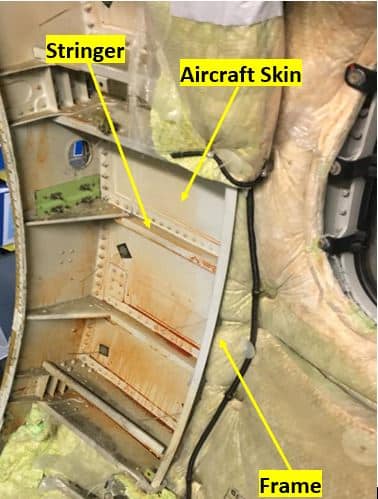The difference between a monocoque and semi-monocoque structure is the way in which they absorb and carry flight loads. A semi-monocoque structure is comprised of structural elements which “carry” the flight loads and stress on the structure of the aircraft. Monocoque structures consist of a design in which only the skin of the aircraft carries the flight loads.
With a semi-monocoque design, these structural and load-bearing elements include the skin of the aircraft, stringers, and the frame. Semi-monocoque structure relates to the fail-safe design concept. Fail-safe design is the concept of integrating a high level of redundancy into aircraft structural design.
This provides a safety margin that protects the aircraft from experiencing a catastrophic failure in flight. A semi-monocoque structure allows for structural integrity to be distributed across the aircraft structure via external (aircraft skin) and internal (stringers, frame, ribs) elements.
This shared characteristic of baring in-flight loads across the airframe means there is no dependence on a single section to provide structural strength. This is especially integral for the primary structural sections of an aircraft.
Early aircraft designs were predominantly of a monocoque design. However, as engineers’ and aircraft designers’ knowledge evolved, it was soon realized that a semi-monocoque structure was more beneficial. In modern-day aircraft design, almost all aircraft are of a semi-monocoque design.

Advantages of a Semi-Monocoque Structure
From a maintenance perspective, semi-monocoque design makes structural inspections and repairs easy to pinpoint. Aircraft engineers are equipped with a manual known as an Illustrated Parts Catalogue (IPC) which maps out the location and identification numbers for all structural elements of an aircraft.
A manual referred to as the Aircraft Structural Repair Manual (SRM) outlines the correct diagnosis and repair procedures for each of these structural elements.
In relation to safety, semi-monocoque structures are far superior to that of monocoque structures. As discussed above, the stresses and flight loads encountered by an aircraft are spread across the airframe rather than on a singular structural component. This makes the risk of a catastrophic in-flight failure less likely.
Costs of structural repairs on semi-monocoque designs are considerably less to that of a monocoque design. This is because individual, smaller structural elements of an aircraft can be repaired or replaced in comparison to a monocoque design in which a larger or entire structure would have to be repaired or replaced.
From an aircraft design aspect, semi-monocoque structures are easier to work with compared to monocoque structures because the rigidity and strength of the aircraft can be significantly more. This allows for maximum design potentials to be realized. Such design potentials include increased Maximum Take-off Weight (MTOW) and increased payload capacity.
Disadvantages of a Monocoque Structure
As has been outlined, semi-monocoque structures are almost always the structural designs chosen for aircraft. This is due to the benefits which they provide exceeding that of the monocoque design. Monocoque structures have several disadvantages:
- Inability to distribute flight loads
- Difficult to maintain
- Expensive to maintain
- Hard to properly diagnose and pinpoint structural issues
- Even minor damage to structure can greatly reduce strength as there is a lack of loads being shared across the airframe
- Hard to apply aircraft structural testing techniques to monocoque design
Main Differences Between Semi-Monocoque and Monocoque Structures
- Flight loads are distributed differently – across multiple structural elements on a semi-monocoque structure compared to a singular one on a monocoque design
- Internal structure of a semi-monocoque design designed to bare loading along with stresses on the aircraft skin (external structure). Monocoque structure consists of just external structural elements (aircraft skin only)
- Semi-monocoque structure integrates a fail-safe design approach, monocoque does not
Read More:
Straight Wing Advantages | Wing Design
Can A Plane Fly Without Wings?

After visiting more than 60 countries, I have probably been on every type of plane there is and visited countless airports. I did my very first international solo trip to South Africa at the age of only 16 and haven’t really stopped traveling since.
Despite the adventurous travel itch, I do have a nerdy side as well – which is satisfied by writing about all things aviation “too boring” for my regular travel blog.

